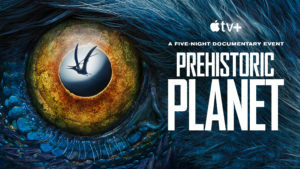This is a transcript of Episode 5.
Travis Holland 0:06
Welcome to Fossils and Fiction, a podcast exploring cultural and scientific ideas about dinosaurs.
This episode of fossils and fiction is a review of the Apple TV Plus series Prehistoric Planet, which is a new wildlife documentary style series about life in the late Cretaceous period when dinosaurs ruled the earth
Apple TV+ 0:43
PREHISTORIC PLANET TRAILER
Travis Holland 1:35
The series is narrated by David Attenborough produced by John Favreau. As you heard in the preview there, each of the five episodes of prehistoric planet said in effectively a different biome. From coasts to deserts, through freshwater, polar regions and forests, we watch up close as both iconic and relatively unknown dinosaur species are brought to life before our eyes. The series features some of the most extraordinary computer generated animals I have ever seen, and also the magnificent landscapes and vistas you would expect from any Attenborough documentary.
From that first episode ‘coasts’, you can tell that this series is special. It features a male Tyrannosaurus rex leading a brood of his offspring across a narrow ocean to feed on large turtles on nearby islands. Like many natural world documentaries, the series shows life in all of its struggle and ugliness, as well as its beauty. The father rex and the babies get a good meal. But baby dinosaurs are also vulnerable to predators. And we see that play out time and time again. Cute they may be, but they live in a deadly world. Though the T rexes were magnificent, the standout for me in this episode were the Mosasauruses and their life on the reef.
Life in the desert is even tougher, as shown in episode two. Here we see giant sauropods for Dreadnoughtus gathering for competition and mating. The vision of these huge creatures with impressive air sacs for display has provoked some controversy, but I was incredibly impressed with the styling of them. We also see a cousin of Tyrannosaurus, the Tarbosaur, and catch a first glimpse of the feathered Velociraptor which differs substantially from those seen in other popular media.
The dinosaurs interacting in the desert episode really do feel like one fully fledged ecosystem. And I think that points to one of the weaker aspects of the freshwater episode, which is that many of the dinosaurs here feel somewhat disconnected from their contemporaries. Mind you, the great shaggy haired oaf that is Deinocheirus is an absolute standout, and one of the most interesting and wild dinosaur designs I have ever seen.
In the ice worlds episode, largely set in the planet’s polar regions, we say multiple dinosaur species in combat for survival. A particular standout for me is the Pachyrhinosaurus, which finds itself in a freezing standoff with a group of therapods.
And finally, we turn to the forests. Here we see dinosaurs in the kinds of environment, they are perhaps most often pictured. And one of the most anticipated scenes from the series trailer finally arrives as a male Carnotaurus shows off his dance moves in the hopes of attracting a female.
A number of the scientists who consulted for the series have been active on Twitter, correcting misconceptions and demonstrating how various research was incorporated into the show. Darren Naish and Steve Brusatte in particular, have been vocal about what they contributed. Here are some clips from Naish explaining the science that went into the show,
Darren Naish 6:33
You have to imagine that what you’re actually seeing the series is like the tip of the iceberg. And there’s this vast amount of kind of, you know, background, scientific backing to every single one of our decisions. So an enormous amount of work, enormous amount of research.
I think we can be very confident that Prehistoric Planet is going to mark a new watershed in terms of the portrayal on the screen of dinosaurs and other animals of the time. This is the modern view of dinosaurs as we understand it right now.
This is going to encourage like a whole new generation of kids and older people as well. So really think about these animals in a new way, and be really interested in them and in the world in general.
Travis Holland 7:22
One of the least discussed aspects of this series is the evocative soundtrack. At all the right moments it is lively and joyous, and then builds tension. it soars just as the pterosaurs do. And it brings us further into the life worlds of these dinosaurs. The composers have to be congratulated for their work. You will have heard some of that music in the preview I played earlier.
If you have any interest in dinosaurs, and I have to assume you do if you’re listening to this podcast, I highly recommend you check out prehistoric planet now streaming on Apple TV plus.
Apple TV+ 8:16
COMPILATION OF PREHISTORIC PLANET CONTENT AND INTERVIEWS
Travis Holland 10:21
Thank you for listening to the fossils and fiction podcast produced by me Travis Holland with the support of Charles Sturt University. The podcast theme music is Sonora by Quincas Moreia via the YouTube Audio Library. Find more content on our social media channels, Twitter, Facebook, YouTube, Instagram, and Tiktok. Show notes are available on the website fossilsfiction.co You can subscribe to the podcast on all major podcasting platforms.


